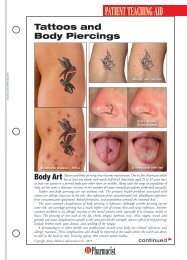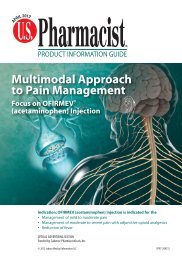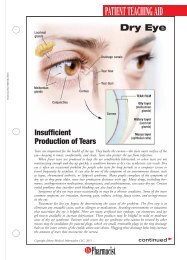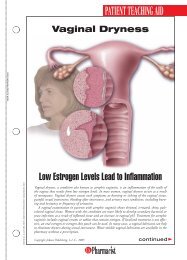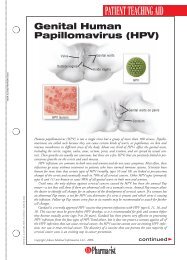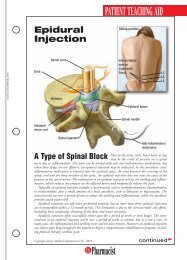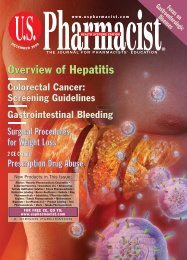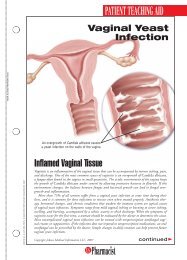View PDF Edition - U.S. Pharmacist
View PDF Edition - U.S. Pharmacist
View PDF Edition - U.S. Pharmacist
Create successful ePaper yourself
Turn your PDF publications into a flip-book with our unique Google optimized e-Paper software.
Brief summary of prescribing information.INDICATIONS AND USAGE CUBICIN (daptomycin for injection) is indicatedfor the following infections (see also DOSAGE AND ADMINISTRATION andCLINICAL STUDIES in full prescribing information): Complicated skinand skin structure infections (cSSSI) caused by susceptible isolatesof the following Gram-positive microorganisms: Staphylococcus aureus(including methicillin-resistant isolates), Streptococcus pyogenes, S. agalactiae,S. dysgalactiae subsp equisimilis, and Enterococcus faecalis (vancomycin-susceptibleisolates only). Combination therapy may be clinicallyindicated if the documented or presumed pathogens include Gram-negativeor anaerobic organisms. Staphylococcus aureus bloodstream infections(bacteremia), including those with right-sided infective endocarditis,caused by methicillin-susceptible and methicillin-resistant isolates. Combinationtherapy may be clinically indicated if the documented or presumedpathogens include Gram-negative or anaerobic organisms. The efficacy ofCUBICIN in patients with left-sided infective endocarditis due to S. aureushas not been demonstrated. The clinical trial of CUBICIN in patients withS. aureus bloodstream infections included limited data from patients withleft-sided infective endocarditis; outcomes in these patients were poor (seeCLINICAL STUDIES in full prescribing information). CUBICIN has not beenstudied in patients with prosthetic valve endocarditis or meningitis. Patientswith persisting or relapsing S. aureus infection or poor clinical responseshould have repeat blood cultures. If a culture is positive for S. aureus,MICsusceptibility testing of the isolate should be performed using a standardizedprocedure, as well as diagnostic evaluation to rule out sequestered fociof infection (see PRECAUTIONS). CUBICIN is not indicated for the treatmentof pneumonia. Appropriate specimens for microbiological examinationshould be obtained in order to isolate and identify the causative pathogensand to determine their susceptibility to daptomycin. Empiric therapy maybe initiated while awaiting test results. Antimicrobial therapy should beadjusted as needed based upon test results. To reduce the developmentof drug-resistant bacteria and maintain the effectiveness of CUBICIN andother antibacterial drugs, CUBICIN should be used only to treat or preventinfections that are proven or strongly suspected to be caused by susceptiblebacteria.When culture and susceptibility information are available, theyshould be considered in selecting or modifying antibacterial therapy. In theabsence of such data, local epidemiology and susceptibility patterns maycontribute to the empiric selection of therapy.CONTRAINDICATIONS CUBICIN is contraindicated in patients withknown hypersensitivity to daptomycin.WARNINGS Clostridium difficile–associated diarrhea (CDAD) has beenreported with use of nearly all antibacterial agents, including CUBICIN,and may range in severity from mild diarrhea to fatal colitis. Treatmentwith antibacterial agents alters the normal flora of the colon, leading toovergrowth of C. difficile. C. difficile produces toxins A and B, which contributeto the development of CDAD. Hypertoxin-producing strains of C.difficile cause increased morbidity and mortality, since these infectionscan be refractory to antimicrobial therapy and may require colectomy.CDAD must be considered in all patients who present with diarrhea followingantibiotic use. Careful medical history is necessary because CDADhas been reported to occur over 2 months after the administration ofantibacterial agents. If CDAD is suspected or confirmed, ongoing antibioticuse not directed against C. difficile may need to be discontinued.Appropriate fluid and electrolyte management, protein supplementation,antibiotic treatment of C. difficile, and surgical evaluation should be institutedas clinically indicated.PRECAUTIONS General The use of antibiotics may promote the selectionof non-susceptible organisms. Should superinfection occur during therapy,appropriate measures should be taken. Prescribing CUBICIN in the absenceof a proven or strongly suspected bacterial infection is unlikely to providebenefit to the patient and increases the risk of the development of drugresistantbacteria. Persisting or Relapsing S. aureus Infection Patientswith persisting or relapsing S. aureus infection or poor clinical responseshould have repeat blood cultures. If a culture is positive for S. aureus,MICsusceptibility testing of the isolate should be performed using a standardizedprocedure, as well as diagnostic evaluation to rule out sequestered fociof infection. Appropriate surgical intervention (eg, debridement, removal ofprosthetic devices, valve replacement surgery) and/or consideration of achange in antibiotic regimen may be required. Failure of treatment due topersisting or relapsing S. aureus infections was assessed by the AdjudicationCommittee in 19/120 (15.8%) CUBICIN-treated patients (12 withMRSA and 7 with MSSA) and 11/115 (9.6%) comparator-treated patients(9 with MRSA treated with vancomycin and 2 with MSSA treated with antistaphylococcalsemi-synthetic penicillin). Among all failures, 6 CUBICINtreatedpatients and 1 vancomycin-treated patient developed increasingMICs (reduced susceptibility) by central laboratory testing on or followingtherapy. Most patients who failed due to persisting or relapsing S. aureusinfection had deep-seated infection and did not receive necessary surgicalintervention (see CLINICAL STUDIES in full prescribing information).Skeletal Muscle In a Phase 1 study examining doses up to 12 mg/kgq24h of CUBICIN for 14 days, no skeletal muscle effects or CPK elevationswere observed. In Phase 3 cSSSI trials of CUBICIN at a dose of 4 mg/kg,elevations in CPK were reported as clinical adverse events in 15/534(2.8%) CUBICIN-treated patients, compared with 10/558 (1.8%) comparator-treatedpatients. In the S. aureus bacteremia/endocarditis trial, at adose of 6 mg/kg, elevations in CPK were reported as clinical adverseevents in 8/120 (6.7%) CUBICIN-treated patients compared with 1/116(500 U/L) at baseline, 2/19 (10.5%) treated with CUBICIN and 4/24(16.7%) treated with comparator developed further increases in CPK whileon therapy. In this same population, no patients developed myopathy.CUBICIN-treated patients with baseline CPK >500 U/L (N=19) did not experiencean increased incidence of CPK elevations or myopathy relative tothose treated with comparator (N=24). In the S. aureus bacteremia/endocarditisstudy, 3 (2.6%) CUBICIN-treated patients, including 1 with traumaassociated with a heroin overdose and 1 with spinal cord compression, hadan elevation in CPK >500 U/L with associated musculoskeletal symptoms.None of the patients in the comparator group had an elevation in CPK>500 U/L with associated musculoskeletal symptoms. CUBICIN should bediscontinued in patients with unexplained signs and symptoms of myopathyin conjunction with CPK elevation >1,000 U/L (~5x ULN), or in patientswithout reported symptoms who have marked elevations in CPK >2,000U/L (10x ULN). In addition, consideration should be given to temporarilysuspending agents associated with rhabdomyolysis, such as HMG-CoAreductase inhibitors, in patients receiving CUBICIN. In a Phase 1 study examiningdoses up to 12 mg/kg q24h of CUBICIN for 14 days, no evidenceof nerve conduction deficits or symptoms of peripheral neuropathy wasobserved. In a small number of patients in Phase 1 and Phase 2 studies atdoses up to 6 mg/kg, administration of CUBICIN was associated withdecreases in nerve conduction velocity and with adverse events (eg, paresthesias,Bell’s palsy) possibly reflective of peripheral or cranial neuropathy.Nerve conduction deficits were also detected in a similar number of comparatorsubjects in these studies. In Phase 3 cSSSI and communityacquiredpneumonia (CAP) studies, 7/989 (0.7%) CUBICIN-treated patientsand 7/1,018 (0.7%) comparator-treated patients experienced paresthesias.New or worsening peripheral neuropathy was not diagnosed in any ofthese patients. In the S. aureus bacteremia/endocarditis trial, a total of11/120 (9.2%) CUBICIN-treated patients had treatment-emergent adverseevents related to the peripheral nervous system. All of the events wereclassified as mild to moderate in severity; most were of short duration andresolved during continued treatment with CUBICIN or were likely due to analternative etiology. In animals, effects of CUBICIN on peripheral nerve wereobserved (see ANIMAL PHARMACOLOGY in full prescribing information).Therefore, physicians should be alert to the possibility of signs and symptomsof neuropathy in patients receiving CUBICIN. Drug InteractionsWarfarin Concomitant administration of CUBICIN (6 mg/kg q24h for 5days) and warfarin (25 mg single oral dose) had no significant effect on thepharmacokinetics of either drug, and the INR was not significantly altered.As experience with the concomitant administration of CUBICIN and warfarinis limited, anticoagulant activity in patients receiving CUBICIN and warfarinshould be monitored for the first several days after initiating therapy withCUBICIN (see CLINICAL PHARMACOLOGY, Drug-Drug Interactions infull prescribing information). HMG-CoA Reductase Inhibitors Inhibitorsof HMG-CoA reductase may cause myopathy, which is manifested asmuscle pain or weakness associated with elevated levels of CPK. Therewere no reports of skeletal myopathy in a placebo-controlled Phase 1 trialin which 10 healthy subjects on stable simvastatin therapy were treatedconcurrently with CUBICIN (4 mg/kg q24h) for 14 days. In the Phase 3 S.aureus bacteremia/endocarditis trial, 5/22 CUBICIN-treated patients whoreceived prior or concomitant therapy with an HMG-CoA reductase inhibitordeveloped CPK elevations >500 U/L. Experience with co-administration ofHMG-CoA reductase inhibitors and CUBICIN in patients is limited; therefore,consideration should be given to temporarily suspending use of HMG-CoAreductase inhibitors in patients receiving CUBICIN (see ADVERSEREACTIONS, Post-Marketing Experience). Drug-Laboratory TestInteractions There are no reported drug-laboratory test interactions.Carcinogenesis, Mutagenesis, Impairment of Fertility Long-termcarcinogenicity studies in animals have not been conducted to evaluate thecarcinogenic potential of daptomycin. However, neither mutagenic norclastogenic potential was found in a battery of genotoxicity tests, includingthe Ames assay, a mammalian cell gene mutation assay, a test for chromosomalaberrations in Chinese hamster ovary cells, an in vivo micronucleusassay, an in vitro DNA repair assay, and an in vivo sister chromatid exchangeassay in Chinese hamsters. Daptomycin did not affect the fertility orreproductive performance of male and female rats when administeredintravenously at doses up to 150 mg/kg/day, which is approximately 9times the estimated human exposure level based upon AUCs. PregnancyTeratogenic Effects: Pregnancy Category B Reproductive and teratologystudies performed in rats and rabbits at doses of up to 75 mg/kg, 2 and4 times the 6 mg/kg human dose, respectively, on a body surface areabasis, have revealed no evidence of harm to the fetus due to daptomycin.There are, however, no adequate and well-controlled studies in pregnantwomen. Because animal reproduction studies are not always predictive ofhuman response, this drug should be used during pregnancy only if clearlyneeded. Nursing Mothers It is not known if daptomycin is excreted inhuman milk. Caution should be exercised when CUBICIN is administered tonursing women. Pediatric Use Safety and efficacy of CUBICIN in patientsunder the age of 18 have not been established. Geriatric Use Of the 534patients treated with CUBICIN in Phase 3 controlled clinical trials of cSSSI,27.0% were 65 years of age or older and 12.4% were 75 years of age orolder. Of the 120 patients treated with CUBICIN in the Phase 3 controlledclinical trial of S. aureus bacteremia/endocarditis, 25.0% were 65 years ofage or older and 15.8% were 75 years of age or older. In Phase 3 clinicalstudies of cSSSI and S. aureus bacteremia/endocarditis, lower clinical successrates were seen in patients 65 years of age compared with those




